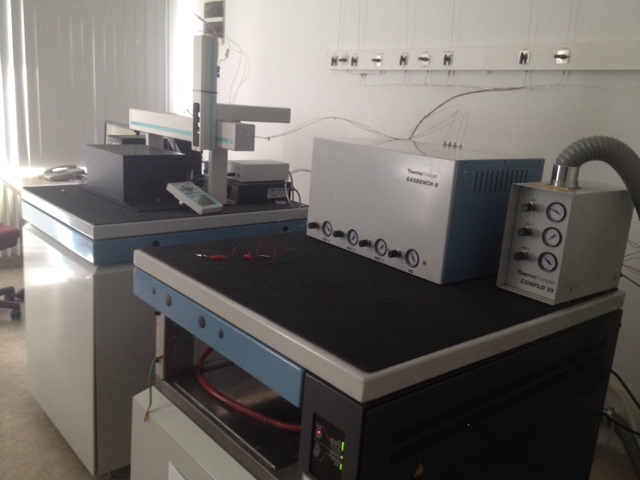Isotope Ratio Mass Spectrometer
The analyses in the Stable isotope laboratory is based on the Continuous Flow Technique, in which the sample gas is entrained in a carrier gas flow (Helium). The Gas Bench is a continuous flow interface, with autosampler assisted loop injection, coupled to a mass spectrometer for the determination of δ18O and δ2H in water samples.
The δ18O and δ2H analyses in water samples are conducted as two separate tests. The analysis of these isotopes involves the transfer of the isotopic ratio of a water sample to a gas to be sent to the mass spectrometer via water-gas isotopic equilibration. The gas to be measured (Equilibration Gas) is injected via a needle into the headspace of the exetainer vial filled with the sample. It is assumed that, after a specific amount of time, an isotopic equilibrium is reached between the gas in the headspace and the molecules in the liquid. After equilibration, the sample gas is taken from the headspace of the exetainer vial via a sampling needle and sent into the Gas Bench for purification and separation from other gas species. Later the gases are transferred to the mass spectrometer for measurement, along with special high purity reference gases.
Instrument: Thermofinnigan, DELTAplusXP

Specifications
- Maximum Acceleration Voltage : 3 keV
- Maximum Field Strength : 0.75 T
- Maximum mass/load Ratio : 70
- Mass Adjustment: It is done by changing the magnetic field strength.
- Vacuum: 10-8 bar (inlet valve closed); 10-6 bar (inlet valve open)
- Detectors : Triple Collector System + two detectors for D and H
- Amplifier Dynamic Range: 50 V
- Measurement Sesitivity:
- D/H : ± 2 (‰)
- 18O/16O : ± 0.2 (‰)
Applications
The device is used to make D/H and 18O/16O measurements on water samples.
Sample Requirements
Water Samples: Water samples should be delivered in glass or polyethylene bottles that are filled to the brim and tightly capped. A minimum of 10 milliliters of sample is required for analysis.
The analyses in the Stable isotope laboratory is based on the Continuous Flow Technique, in which the sample gas is entrained in a carrier gas flow (Helium). The Gas Bench is a continuous flow interface, with autosampler assisted loop injection, coupled to a mass spectrometer for the determination of δ18O and δ2H in water samples.
The δ18O and δ2H analyses in water samples are conducted as two separate tests. The analysis of these isotopes involves the transfer of the isotopic ratio of a water sample to a gas to be sent to the mass spectrometer via water-gas isotopic equilibration. The gas to be measured (Equilibration Gas) is injected via a needle into the headspace of the exetainer vial filled with the sample. It is assumed that, after a specific amount of time, an isotopic equilibrium is reached between the gas in the headspace and the molecules in the liquid. After equilibration, the sample gas is taken from the headspace of the exetainer vial via a sampling needle and sent into the Gas Bench for purification and separation from other gas species. Later the gases are transferred to the mass spectrometer for measurement, along with special high purity reference gases.
Instrument: Thermofinnigan, DELTAplusXP

Specifications
- Maximum Acceleration Voltage : 3 keV
- Maximum Field Strength : 0.75 T
- Maximum mass/load Ratio : 70
- Mass Adjustment: It is done by changing the magnetic field strength.
- Vacuum: 10-8 bar (inlet valve closed); 10-6 bar (inlet valve open)
- Detectors : Triple Collector System + two detectors for D and H
- Amplifier Dynamic Range: 50 V
- Measurement Sesitivity:
- D/H : ± 2 (‰)
- 18O/16O : ± 0.2 (‰)
Applications
The device is used to make D/H and 18O/16O measurements on water samples.
Sample Requirements
Water Samples: Water samples should be delivered in glass or polyethylene bottles that are filled to the brim and tightly capped. A minimum of 10 milliliters of sample is required for analysis.
